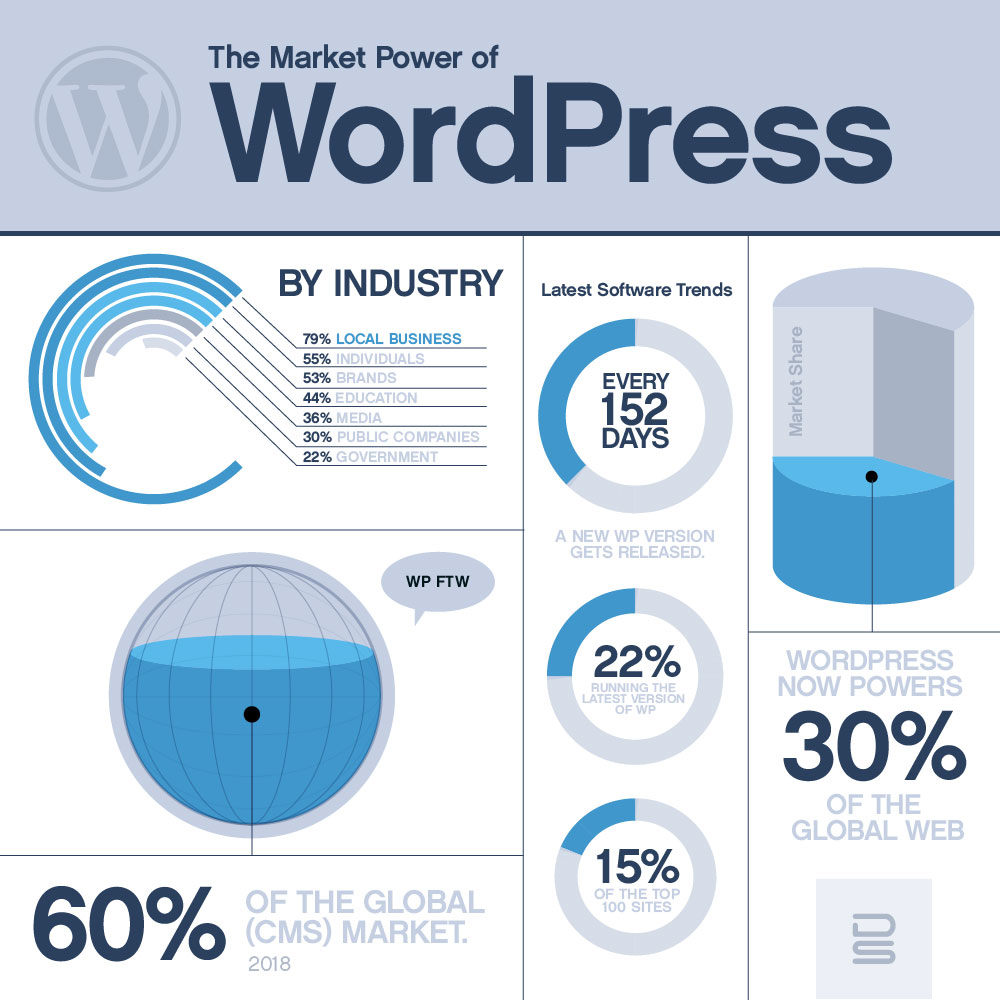Build a Website Using WordPress.
You’ve heard of it, or you haven’t either way, something like 30% of all new websites being built right now are authored on WordPress code. It’s market hold is growing and for good reason, we predict that it’s going to continue to be a hot trend in the web technology of the future. Certainly it’s not the end-all-be-all of CMS systems, (Content Management Systems) the really big brand shopping systems are usually done by a solid in-house or in-agency web team and built with something completely custom. The best systems are then maintained daily for bugs, usability issues, and outfitted with constant improvements.
So what is WordPress?
Zip back like a decade ( or more, actually they started in 2003 ) and you may remember a world wide web that did not appear on a phone, and was populated mainly by HTML coded sites. Frame borders showing, garbage repeat photoshop background textures, typeset in Times New Roman or just system Helvetica fonts, and plain old blue underlined hyperlinks. Around this era, a team of very talented folks got together in an effort to make something better and more powerful, using .PHP. It started with MyPHP Forums, and then Myspace, Facebook, and now… all the best entities have sites that are driven off of .PHP code. It hides the .html extension on files, and offers insane functionality enhancements. No limit. Really, what ever you can dream up.
Simply said, WordPress is a free package of core .PHP software that will let you build a blog / website, where the data is stored in a database next to the actual page files. It’s fast, secure, and exponentially expandable, with out having to know a shit ton of code to make changes. Most of the time, you don’t need to tweak code at all. These guys are ninjas by today’s standards of web development, and they are still at it. WordPress is “Open-Source” which means it lives and breathes and changes with the trends of the worlds web needs.
Folks are still making it better, and creating custom plug-in patches and side systems to integrate into it.
What’s the catch. Some people hate WP, why?
The catch is that they are constantly getting software updates. New code, new plugins, new security enhancements, mobile responsiveness, etc. So they need to be set up by a talented web team that understands the industry’s best practice of installation.
You need to set them up with what’s called a “Child-Theme” if you don’t, when you update your versions, kiss all your customizations good bye. This is a big deal. And no Godaddy’s one step installation will not do this for you. You need to get into the Server and move file folders around. If you let them age, they will eventually become a nightmare to fix, and in some cases take just as long to update as it took to build them from the start… Not fun, or affordable. It’s ideal to keep current with your software. Ask your web team if they offer monthly retainers for tech support, and put them on the hook to run your updates monthly. Just a couple of hours should suffice if you average the tasks out.
What kind of costs am I looking at?
Before we shed light on your dollar investment options, you need to think differently about cost.
How would a really low quality investment affect sales down stream? Truth is, that the cost of a great website will more than pay for itself in annual sales. Where as the cost of an amateur website build will not offer the same value to your bottom line. Ugly and glitchy have never been in fashion…
That said, the average cost to have a specialist build out a WordPress site can range based on category…
Use the notes below to give yourself a ball park of on investment.
One pager.
Anywhere from $500-1000 for a one page site. ( Depending on your developers hourly fees. )
The people who tell you then can do it for $99 are not going to deliver you anything of quality, and I’m sure they will hook you onto other downstream costs before you can actually launch anything. Buyer beware. Nothing good is ever cheap, and nothing cheap is ever really very good quality. To get your site started, one page is a good first step.
Quality Multi-Page.
For multi-page high quality website presentations, with solid graphics, and a story worth reading, you should open your budget to around $3-5K. This should give the development team time to do a design round with approvals, and code out something really slick.
Base E-Commerce.
For an eCommerce website with a handful of products, or at least the infrastructure to handle a growing product line. Tickets can go $5k-10k.
Remember that means you’d also have a multipage presentation next to your cart system.
A Rocket Ship E-Commerce.
For a rocket ship eCommerce build out, where you bring your web tech on to do everything, from the multipage presentation, to the cart infrastructure and then the product entries and system testing. This a full time job ranging anywhere from $20k-60k depending on the product line. For example, if you have 100 products, and it takes half an hour to put the photos, the product text and some customizations in… 100x.5 = 50 hrs plus the other parts of the site it self, plus the graphic building and content writing… You’re in deep. 200 products, 300 products, 400, 500 etc. Cost is all dependent on size and scope. Consider finding a source you can rely on through out the year, and for the years to come.
In Summary.
Those ball parks maybe off by some standards, but the fact remains, it takes a tech savvy grunt in a chair staring at a screen for hours and hours to make it all come to life. It’s not something you can just hack and hope to save a few bucks on. It’s an investment in your company’s first and best salesperson, one that never sleeps, and can be told to say what ever you tell them to. The value it presents to any tech minded business is immeasurable.
How Do I start?
Step one.
Get on the phone with us and let’s do a complimentary consultation. Have your wish list written down and ready to discuss.
Selfless plug…. 203-775-7157
Step two.
Throw some grease on the wheel and put a deposit in motion for at least some percentage of the total ticket based on the scope we determine fits your wish list, your needs and budget allowance.
Step three.
Be patient. Remember it takes a quality tech to do once and do it right. Make sure you give them all the assets at the beginning. Time is always lost waiting for text and photos, and or changing those things again and again once they are in the system.
Step four.
Keep eyes on the scope, and make sure you pay only for what you want, and not what you don’t.
Nothing kills a relationship with a developer faster than demanding or asking for things that are out of scope and not putting funds to back up the request. No one wants to work for free. If you want to add more, prepare to ask for an additional add on to the scope at what ever agreed costs fit the needs.
Step five.
Be ready to send approvals and or edits and then sit back an watch it come to life.
Step 6…
Wow so many steps…. Once it’s live, let it have a soft launch, so you can debug and consider new items to open in a new scope of work. You won’t know how you’ll really want to “pimp out” the system until you see it live and start surfing.
Step 7.
Last one I promise. Market the hell out of the system. You’ve built a technical marvel, that is sitting on a shelf with literally billions of other websites. No one will find you unless you do some marketing. SEO and content blogging, as well as page building are all part of this. A website is never ever done.
Step 9…. Just kidding. just contact us and let’s do a Q&A in real time.

